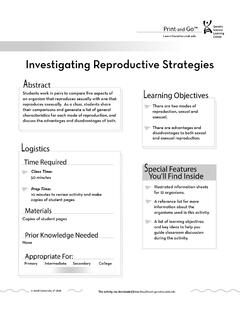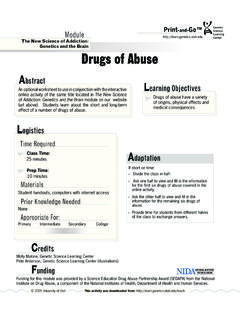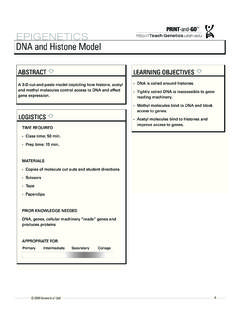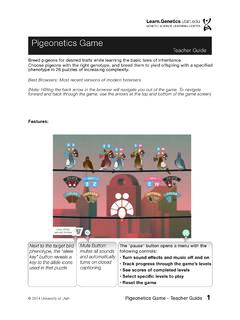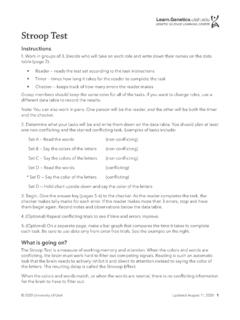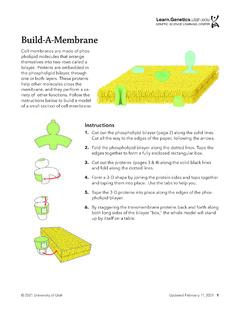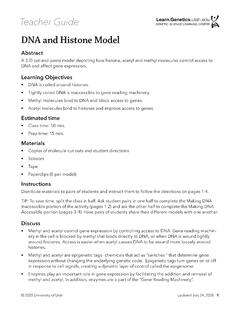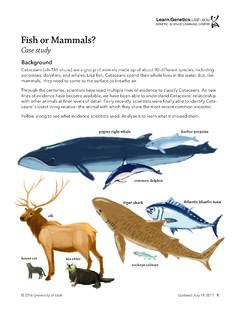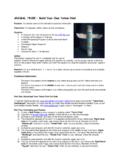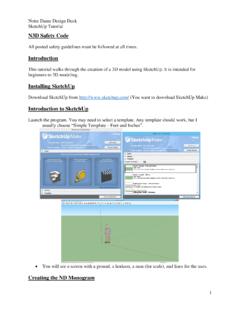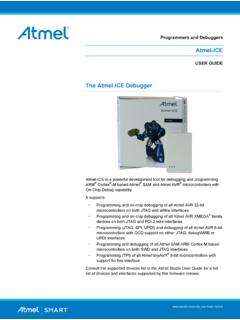Transcription of Reading DNA - University of Utah
1 Teacher Guide 2020 University of UtahUpdated July 30, 2020 1 Reading DNAA bstractStudents use edible models of the DNA molecule to transcribe an mRNA sequence, then translate it into a Objectives Students will understand that information within the DNA molecule is divided into segments called genes. Students will learn that each gene contains the instructions for assembling a unique protein that performs a specialized function in the cell. Students will be able to summarize the two-step process of transcription and translation by which the information in a gene is used to construct a time Class time 45 minutes Prep time 60 minutesMaterials tape scissors Per student or group 1 black licorice stick (Twizzlers) colored marshmallows, 9 each of pink (labeled U with marker), orange, yellow, and green 6 toothpicks, cut in half colored circle cut-outs, 2 each of red, pink, dark yellow, light yellow, green, blue, and purpleTIP.
2 Laminate them for continued use and put each group s cut-outs in an envelope edible models of DNA previously built for the activity Have your DNA and Eat It TooBackground InformationThe DNA molecule has the same basic structure and function in all living things. It carries the in-structions for building and operating an organism in the form of a sequence of chemical bases each represented by the first letter of its name: adenine (A), cytosine (C), guanine (G), and thymine (T). Human cells contain forty-six DNA molecules that when tightly packaged during cell division can be visualized as forty-six chromosomes. The sequence information in each DNA molecule is divided into segments called genes.
3 Each gene contains a blueprint for constructing a unique protein that has a specialized function in the cell. Upon completion of the Human Genome Project in the year 2003, it was determined that humans 2020 University of UtahInsert Activity Title Here Teacher Guide 2have approximately 20,000 genes. Scientists now have the enormous task of deciphering how these genes direct the development and maintenance of an organism as complex as the human human body with its different tissues and organs requires a large variety of cell types to function, yet every human cell contains the exact same set of DNA instructions. How, then, can the diversity among cells be explained?
4 Different cell types arise because each cell uses different combinations of genes, building only the proteins it will need to perform its special job. To assem-ble a protein using the information in a gene, a cell employs the two-step process of transcription and translation. After a cell has chosen a gene from which it will build a protein, it makes a copy of the information in the form of messenger ribonucleic acid (mRNA) to send to the protein-building machinery. The synthesis of an mRNA molecule from a DNA template is referred to as transcription. The structure of mRNA is very similar to DNA in that it has a sugar-phosphate backbone to which the chemical bases are attached.
5 However, there are some important differences: (1) mRNA is single-stranded and therefore does not form a double helix, (2) the sugar used to form the backbone is slightly different, and (3) the chemical base thymine (T) is replaced by uracil (U). The sequence of the mRNA molecule is determined by using one strand of the DNA molecule as a template and applying the rules of base pairing. Except, the base adenine (A) will now cause uracil (U) instead of thymine (T) to be added to the mRNA sequence. Note that the mRNA sequence is a complement of its DNA template. Once the DNA information has been copied or transcribed, the mRNA leaves the nucleus and enters the cytoplasm where the instructions it contains are used by the cell s protein-building machinery to assemble a protein.
6 The process of assembling a protein from an mRNA transcript is referred to as translation. The protein-building machinery (an enzyme called the ribosome) reads the mRNA sequence three letters at a time. Each combination of three letters codes for a particular protein building block called an amino acid. There are twenty amino acids for the machinery to choose from. The order in which the amino acids are assembled is different for all proteins. The amino acid sequence deter-mines the shape of the protein, and provides the characteristics that enable it to perform a special-ized function in the cell. The three-letter codes used by the protein-building machinery to assemble a protein are collectively referred to as the Universal Genetic Code.
7 It is universal because all living organisms use the same three-letter codes to specify the same amino acids. Instructions1. Begin class with a discussion about genes. Explain that the information in DNA is divided into segments called genes. Each gene contains the instructions for building a particular protein. Proteins do the majority of the work in our cells and make it possible for cells to perform special jobs. 2. Discuss general protein functions, enzymes catalyze (speed up) chemical reactions, trans-port proteins carry small molecules or ions across the cell membrane, signaling proteins carry signals from cell to cell, structural proteins give cells their different shapes, etc.
8 2020 University of UtahInsert Activity Title Here Teacher Guide 33. Provide specific examples for each general protein function you discuss. You might use the following examples: DNA polymerase is an enzyme that makes new DNA, hemoglobin in red blood cells carries oxygen to tissues and organs, insulin hormone acts as a signaling protein to control glucose levels in the blood, -keratin forms fibers that reinforce the structure of epithelial cells and is the major protein in hair. 4. Explain that students will be using the edible DNA models they built previously to simulate the two-step process a cell follows to build a protein, namely transcription and translation.
9 In the first step, a cell reads the information in a gene and makes a copy (called mRNA) to send to the protein-building machinery (an enzyme called the ribosome) in the cytoplasm of the cell. The process of making an mRNA molecule from a DNA template is referred to as the structural differences between the DNA and mRNA molecules, and how the rules of base pairing ensure that an exact copy of the DNA instructions is made. Include in your discussion that the adenine (A) in DNA now directs the base pair uracil (U) to be inserted into the mRNA sequence. In the second step, the sequence information contained in the mRNA molecule is used by the ribosome to string together amino acids, or protein building blocks.
10 This process is called translation. The order in which the amino acids are assembled dictates the shape and func-tion of the Have students work with a partner(s) to complete the activity. Follow the instructions in the student handout to transcribe and translate the short gene sequence in students edible DNA models. 6. When students have completed the activity discuss the Universal Genetic Code. Emphasize that it is universal because all living cells use the same code when Reading mRNA and building pro-teins. Show students how to use the code to find the names of the amino acids in their assem-bled Assess student understanding by checking the mRNA and amino acid sequences to ensure students have followed the rules of base pairing and correctly assembled the Before students begin the activity, lead them through the steps of transcription and translation using the interactive animations What Makes a Firefly Glow and/or Transcribe and Translate a Gene.
